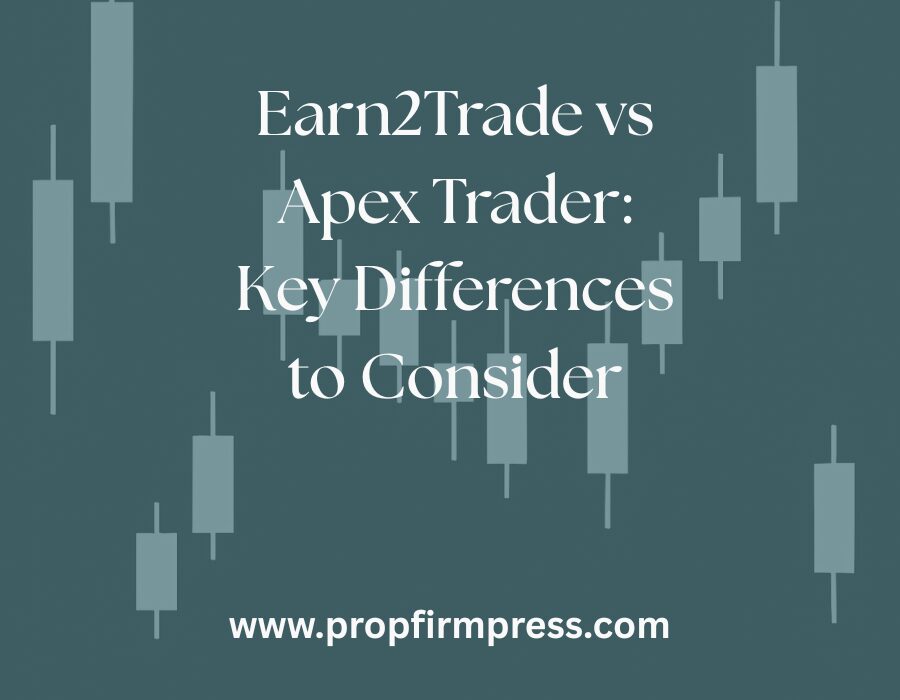Two Popular Futures Prop Firms, One Big Decision
When evaluating proprietary trading firms, Earn2Trade and Apex Trader Funding are two of the most frequently compared platforms—especially among futures traders. Both offer funded accounts, evaluations, and payout models designed to support skilled traders with limited capital. But while they may look similar at first glance, the structure, rules, and long-term value differ significantly.
Understanding these differences can help you choose the platform that aligns best with your trading style, time commitment, and growth goals. In this side-by-side breakdown, we’ll compare everything from evaluation models to payouts, so you can make an informed decision between Earn2Trade and Apex.
Evaluation Structure: One-Phase vs Multi-Account
Earn2Trade offers two main evaluation types:
- The Gauntlet Mini: A 15-day minimum evaluation with trailing drawdown, daily loss limits, and a fixed profit target.
- The Gauntlet: A 60-day evaluation with more flexibility and swing trading permission.
Apex Trader Funding offers a range of evaluation accounts, but all follow a similar one-step model. You choose an account size ($25K to $300K+), pass the profit target without violating drawdown rules, and receive funding. Apex accounts do not require minimum trading days to pass, making it possible to complete the evaluation quickly.
Key difference: Apex is built for speed. Earn2Trade emphasizes consistency and rule-following.
Profit Targets and Drawdown Rules
Both firms enforce profit targets and drawdown limits, but they operate differently:
- Earn2Trade: Requires both trailing drawdown and daily loss limit compliance. Drawdown moves up with account equity but never back down.
- Apex: Uses a trailing threshold as well, but does not include a daily loss limit during the evaluation phase.
This gives Apex more flexibility for aggressive traders, while Earn2Trade rewards disciplined, measured risk-taking.
Minimum Trading Days
Earn2Trade: Requires a minimum of 15 trading days (Gauntlet Mini) or 60 calendar days (Gauntlet). This encourages consistency across multiple sessions and prevents traders from “lucking into” one big win.
Apex: No minimum trading days. If you hit the profit target in one day without a violation, you can qualify for funding immediately.
Best for: Short-term high performers may prefer Apex. Traders who want to develop consistency may appreciate Earn2Trade’s structure.
Allowed Instruments
Both firms allow trading popular CME futures contracts such as:
- ES (E-mini S&P 500)
- NQ (E-mini Nasdaq 100)
- YM (Dow futures)
- CL (Crude oil)
- GC (Gold)
Apex also supports trading some micros and lesser-known contracts. Earn2Trade has a more controlled environment during evaluations but expands available products after funding is secured.
Pricing and Promotions
Earn2Trade: Regular pricing is slightly higher than Apex, but often includes discounts and bundled deals. For example, the $50K Gauntlet Mini account typically costs around $150/month, with periodic sales available using affiliate links like this one.
Apex: Frequently runs massive promotions—up to 80-90% off lifetime pricing—making their evaluations one of the most affordable on the market.
If you’re budget-conscious or testing the waters, Apex’s frequent sales might provide easier entry. Earn2Trade’s price reflects a more curated experience with personalized feedback and trader support.
Scaling Potential
Once funded, how much can you grow?
- Earn2Trade: Partners with Helios Trading Partners to offer scaling beyond $100K. Traders can increase their account size as they build profit consistency and avoid violations.
- Apex: Allows traders to hold multiple funded accounts simultaneously—sometimes up to 20 or more. This provides massive scaling, though it comes with more complexity and capital at risk.
Conclusion on scaling: Apex is great for volume-based growth across accounts. Earn2Trade supports sustainable single-account scaling with capital behind it.
Payout Model
Both firms offer funded traders a share of their profits, but with different payout structures:
Earn2Trade:
- Payouts available after first 15 trading days
- Initial withdrawal cap applies (e.g., $2,000)
- Payouts handled through their funding partner
Apex:
- Payouts begin after 10 trading days
- First $25,000 in profits are 100% yours
- After that, a 90/10 split is applied
Apex provides a higher initial payout rate but has lower evaluation oversight. Earn2Trade offers more structure and hands-on support once you’re funded.
Customer Support and Community
Earn2Trade: Offers one-on-one support, educational resources, and access to a structured trader dashboard. The community includes educators, professional risk managers, and detailed analytics through their client portal.
Apex: Provides email support and a large trader Discord group. Their platform is simpler but doesn’t include as much trader education or review feedback during evaluations.
If you value education and mentorship, Earn2Trade may be a better fit. If you’re self-sufficient and just want to get funded fast, Apex has what you need.
Which Prop Firm Is Right for You?
Choosing between Earn2Trade and Apex Trader comes down to trading personality and priorities.
Choose Earn2Trade if:
- You want a structured learning environment
- You prefer swing trading (via Gauntlet)
- You value long-term scalability
- You want personalized support and rule feedback
Choose Apex Trader if:
- You want fast evaluations
- You trade intraday with a high-frequency approach
- You want multiple funded accounts
- You want large payouts early on
Many traders try both firms at different times, using one for high-speed testing (Apex) and another for serious career building (Earn2Trade). Regardless of which path you choose, both firms offer legitimate opportunities for futures traders to get funded, scale, and earn—if they stick to the rules and treat the evaluation seriously.
